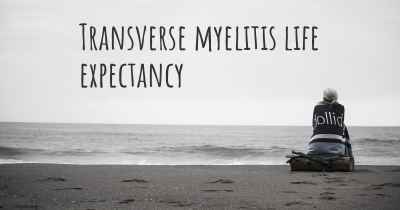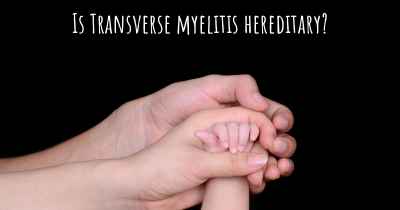22
Transverse myelitis prognosis
What is the prognosis if you have Transverse myelitis? Quality of life, limitations and expectatios of someone with Transverse myelitis.

Although most people with transverse myelitis have at least partial recovery, it may take a year or more. Most recovery occurs within the first three months after the episode and strongly depends on the cause of transverse myelitis.
About one-third of people with transverse myelitis fall into one of three categories after an attack:
No or slight disability. These people experience only minimal lingering symptoms.
Moderate disability. These people are mobile, but may have difficulty walking, numbness or tingling, and bladder and bowel problems.
Severe disability. Some people may permanently need a wheelchair and require ongoing assistance with daily care and activities.
It's difficult to predict the course of transverse myelitis. The prognosis and responsiveness to treatment is strongly determined by the cause of the syndrome and to some extent by how early treatment is administered. Generally, people who experience a rapid onset of severe signs and symptoms and those who have a positive test for a particular antibody have a worse prognosis than do those with a relatively slower onset, milder symptoms and negative antibody test.
About one-third of people with transverse myelitis fall into one of three categories after an attack:
No or slight disability. These people experience only minimal lingering symptoms.
Moderate disability. These people are mobile, but may have difficulty walking, numbness or tingling, and bladder and bowel problems.
Severe disability. Some people may permanently need a wheelchair and require ongoing assistance with daily care and activities.
It's difficult to predict the course of transverse myelitis. The prognosis and responsiveness to treatment is strongly determined by the cause of the syndrome and to some extent by how early treatment is administered. Generally, people who experience a rapid onset of severe signs and symptoms and those who have a positive test for a particular antibody have a worse prognosis than do those with a relatively slower onset, milder symptoms and negative antibody test.
Posted Aug 16, 2022 by Transverse Myelitis Folks Blue Crew
It can be chronic, progressive, or a recovery can be made in 30% of patients diagnosed. Your life will be what you make of it. Mind over matter and a strong PMA will help.
Posted Nov 30, 2017 by mikado54mark 3150
About 1/3rd patients can regain 70-80% mobility through PT and other treatments, 1/3rd will gain less, like 40%, and 1/3rd will likely not regain any mobility. The length of time for recovery varies by individual.
Posted Jun 1, 2018 by Clay Garner 2500
I have relapses and stretches of feeling ok I wasn't told it's progressive but it won't get better
Posted Jun 1, 2021 by Gary 3550
Although most people with transverse myelitis have at least partial recovery, it may take a year or more. Most recovery occurs within the first three months after the episode and strongly depends on the cause of transverse myelitis.
About one-third of people with transverse myelitis fall into one of three categories after an attack:
No or slight disability. These people experience only minimal lingering symptoms.
Moderate disability. These people are mobile, but may have difficulty walking, numbness or tingling, and bladder and bowel problems.
Severe disability. Some people may permanently need a wheelchair and require ongoing assistance with daily care and activities.
It's difficult to predict the course of transverse myelitis. The prognosis and responsiveness to treatment is strongly determined by the cause of the syndrome and to some extent by how early treatment is administered. Generally, people who experience a rapid onset of severe signs and symptoms and those who have a positive test for a particular antibody have a worse prognosis than do those with a relatively slower onset, milder symptoms and negative antibody test.
About one-third of people with transverse myelitis fall into one of three categories after an attack:
No or slight disability. These people experience only minimal lingering symptoms.
Moderate disability. These people are mobile, but may have difficulty walking, numbness or tingling, and bladder and bowel problems.
Severe disability. Some people may permanently need a wheelchair and require ongoing assistance with daily care and activities.
It's difficult to predict the course of transverse myelitis. The prognosis and responsiveness to treatment is strongly determined by the cause of the syndrome and to some extent by how early treatment is administered. Generally, people who experience a rapid onset of severe signs and symptoms and those who have a positive test for a particular antibody have a worse prognosis than do those with a relatively slower onset, milder symptoms and negative antibody test.
Posted Aug 17, 2022 by Kevin Weilacher 3420
Prognosis is very variable. Some people have a good recovery, but some do not.
Posted Aug 17, 2022 by gloria_kazan 7450








